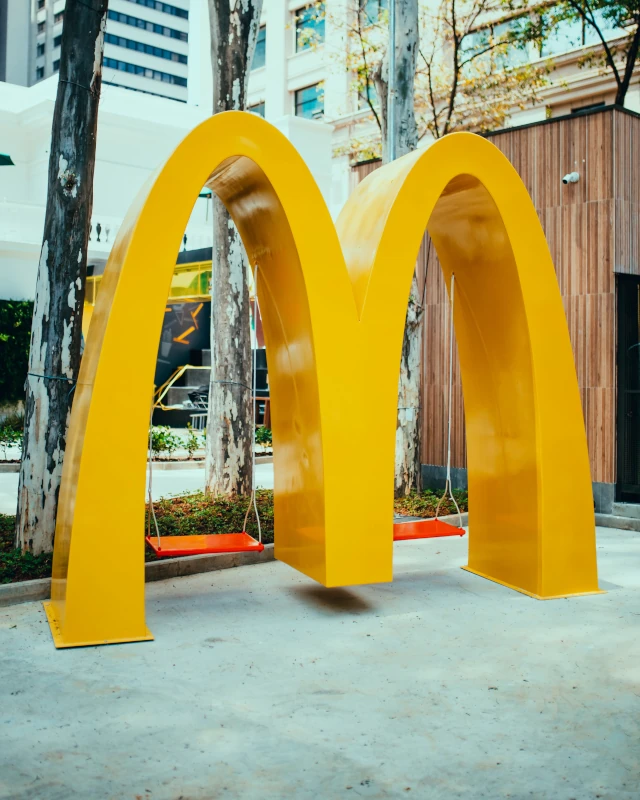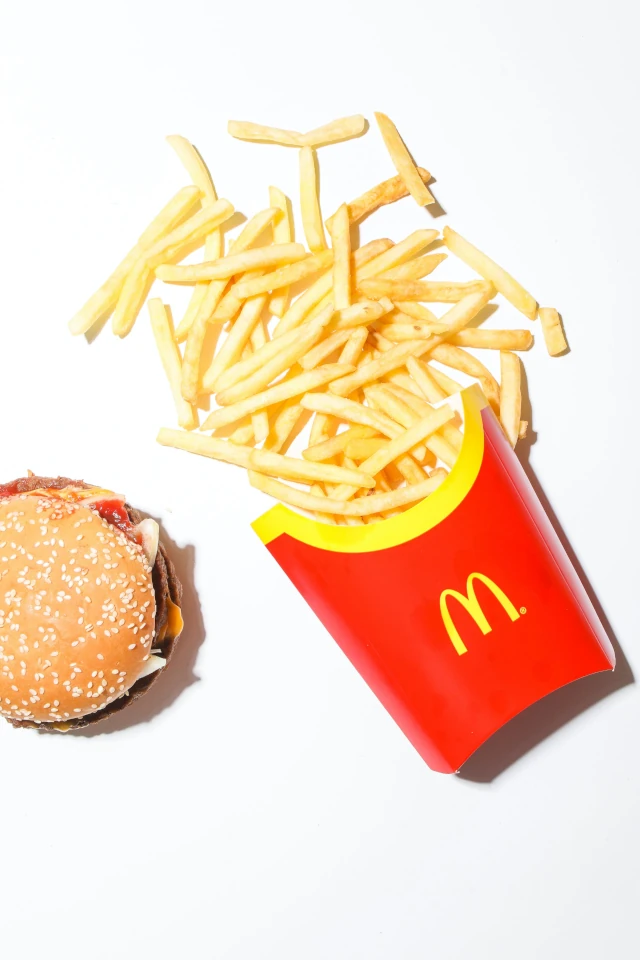McDonald’s transcends mere burgers. It’s a symbol of globalization, serving millions daily across more than120 countries. Its ubiquity reflects the rise of a standardized consumer culture. The golden arches represent familiarity, offering comfort food and predictable service amidst cultural differences. Yet, it adapts! Local menus cater to diverse palates, showcasing its cultural sensitivity. From economic engine to community hub, McDonald’s impact is undeniable, shaping food trends, influencing business models, and even sparking cultural debates. It’s not just fries and shakes; it’s a snapshot of our interconnected world, bite by bite.

Why Marketing is Critical to McDonald’s Success
McDonald’s marketing strategy is like a secret sauce, carefully concocted to maintain its position as the world’s biggest burger chain. Here are some key ingredients:
Building Brand Recognition
The famous Golden Arches are everywhere, and are instantly recognizable, plastered on restaurants worldwide, creating a sense of familiarity and trust. From packaging to uniforms, McDonald’s maintains a consistent brand image, reinforcing its identity across cultures – wherever you are in the world, you can always easily spot a McDonald’s restaurant, and be confident in what kind of food it will serve.
Targeting Families
Appealing to children with Happy Meals, fun toys and characters like Ronald McDonald fosters brand loyalty from a young age. Playgrounds and indoor play areas create a welcoming environment for families, making McDonald’s a go-to destination for parents with kids.
Value and Convenience
McDonald’s offers affordable budget-friendly options, making it accessible to a broad customer base, including young people and families on low-incomes. Drive-thru and online delivery options cater to people busy lifestyles with quick and convenient service – for most people McDonalds represents the ultimate convenience food. McDonald’s is known to be a brand that pioneered the whole concept of fast food.
Adapting to Local Tastes
McDonald’s tailors its menus to regional preferences, offering items like the McSpicy Paneer in India or the Samurai Pork Burger in Japan. So even though you can get a Big Mac anywhere in the world, you’ll also be able to buy something more in tune with local tastes. Understanding and respecting local customs and traditions fosters a positive brand image in diverse markets. McDonalds is good at becoming a part of local cultures.

Embracing Technology
The McDonald’s mobile app allows for easy ordering, delivery, and loyalty rewards, enhancing customer experience and engagement, while the brand’s use of social media and targeted online advertising helps it to reach new audiences and stay relevant.
By combining these elements, McDonald’s marketing strategy creates a powerful recipe for success. It builds brand loyalty, attracts new customers, and adapts to changing tastes and technologies, ensuring the golden arches continue to shine brightly in the fast-food landscape.
McDonald’s marketing strategy has also faced criticism for unhealthy food options and targeting children. However, the company has made efforts to address these concerns by introducing healthier menu items and promoting responsible marketing practices.
The company’s marketing strategy is a masterclass in building a global brand that resonates with people of all ages and cultures. It’s a testament to the power of marketing in driving business success.
Beginnings of McDonald’s Marketing Strategy
In the early days, McDonald’s wasn’t the burger behemoth we know today. To grab a foothold in the competitive food scene, it had to get creative with their marketing.
Introduced in the 1950s, the Speedee Service System streamlined cooking process ensured fast service, appealing to families with hungry kids.McDonald’s was one of the first fast-food chains to add playgrounds, making it a destination for families and fostering brand loyalty among young customers.
Ronald McDonald, the world famous cheerful clown mascot, was introduced in 1963 and became an instant hit with children, further solidifying McDonald’s image as a family-friendly restaurant.
Affordability was always a key part of McDonald’s strategy. Launched in 1983, the Dollar Menu offered a selection of popular items for just $1, making McDonald’s an accessible option for budget-conscious families.
The company has made good use of catchy jingles and slogans in its advertising, for example “I’m Lovin’ It”- This instantly recognizable jingle, introduced in 2003, became a global phenomenon, further boosting brand recognition and positive associations. Also “You Deserve a Break Today” used in the 1970s and 80s, resonated with working families, positioning McDonald’s as a reward and a break from the daily grind.
Community Engagement
McDonald’s actively involved itself in local communities, fostering goodwill and building positive relationships with customers, through activities such as sponsoring local events and sports teams.
Supporting Ronald McDonald House Charities, which provide housing and care for sick children, helped build McDonald’s image as a caring and responsible corporate citizen.
These early marketing strategies laid the foundation for McDonald’s global success, and continue to resonate with customers around the world.
Brand Positioning
McDonald’s brand positioning revolves around being a convenient, family-friendly, and affordable fast-food option. Consistency in branding and messaging is crucial for reinforcing this image across diverse markets. The golden arches, iconic logo, and recognizable color scheme serve as visual anchors, instantly associating the brand with familiarity and reliability worldwide.
Consistent messaging, whether through slogans like “I’m lovin’ it” or advertising campaigns featuring Ronald McDonald, creates a cohesive brand identity. This consistency cultivates trust, allowing customers to know what to expect regardless of location, fostering loyalty and ensuring McDonald’s remains a top-of-mind choice in the competitive fast-food landscape.
Product Innovation
McDonald’s consistently innovates its menu to cater to evolving consumer preferences and local tastes. Introducing new items like regional specialties or adapting classics to suit local cuisines demonstrates its commitment to embracing diversity. For instance, offering items like the McSpicy Paneer in India or the Teriyaki McBurger in Japan showcases this adaptability.
Moreover, responding to health concerns, McDonald’s has expanded its menu to include healthier options, such as salads, grilled items, and fruit sides. Menu changes, like reducing portion sizes and incorporating nutritional information, align with shifting consumer demands for healthier eating habits.
Continual menu evolution not only reflects responsiveness to health trends but also demonstrates McDonald’s agility in staying relevant and appealing to a wide customer base while respecting regional tastes and dietary preferences.
Audience Segmentation
McDonald’s exemplary target audience segmentation is the cornerstone of its successful marketing campaigns. By understanding and catering to diverse demographics, McDonald’s maximizes its appeal and relevance across different consumer groups. The brand’s ability to resonate with various audiences is evident through its tailored campaigns, each crafted to speak directly to specific demographics.

One standout example is McDonald’s approach to children and families. The inclusion of Happy Meals with toys, colorful play areas, and cheerful advertising featuring beloved characters like Ronald McDonald has made the brand synonymous with family outings. This targeted strategy not only entices children but also appeals to parents seeking a family-friendly dining experience.
In contrast, McDonald’s doesn’t solely focus on families; it also caters to young adults and teenagers. Campaigns often feature trendy music, youth-oriented promotions, and collaborations with pop culture icons. Initiatives like the “McDonald’s All-American Games” or tie-ins with popular movies resonate with this demographic, positioning McDonald’s as a cool and relevant choice.
Campaigns emphasizing fresher ingredients, nutritional information, and the introduction of salads and other healthier options aim to attract individuals seeking balanced food choices. This targeted approach acknowledges the importance of health without alienating its broader customer base.
The brand effectively targets specific regional preferences. In Asian markets, for instance, McDonald’s offers items like the McSpicy Chicken Burger or rice-based dishes, aligning with local tastes. Meanwhile, in European markets, emphasis on coffee offerings and cafe-style ambiance caters to consumers seeking a coffeehouse experience.
By segmenting its audience and crafting tailored campaigns, McDonald’s resonates with diverse demographics, ensuring its messaging speaks directly to each group’s desires and values. This nuanced approach allows the brand to maintain a strong connection with a wide array of consumers, contributing significantly to its global success.
McDonald’s Advertising and Promotion Strategy
McDonald’s advertising strategy has been a masterclass in capturing attention across various mediums, embracing everything from traditional TV and print to modern digital platforms. Their multi-faceted approach ensures a ubiquitous presence that remains top-of-mind for consumers globally.
The company’s TV commercials have been iconic, employing vibrant colors, catchy jingles, and relatable scenarios. From heartwarming family moments to youth-focused narratives, their ads strike emotional chords while showcasing menu items. These commercials often feature happy faces enjoying meals, promoting a sense of community and joy around the brand.
McDonald’s leverages social media platforms exceptionally well to engage with its audience. Engaging campaigns, interactive content, and user-generated campaigns keep the brand relevant and connected. They utilize platforms like Facebook, Twitter, Instagram, and TikTok to share promotions, behind-the-scenes glimpses, and user-generated content, fostering a sense of community and participation.
It also invests in print media and outdoor advertising. Bold and visually appealing designs are used in print ads, showcasing the iconic products alongside limited-time offerings. Outdoor ads, strategically placed in high-traffic areas, reinforce brand visibility and often include playful or mouthwatering imagery to attract attention.
The brand has consistently utilized memorable slogans like “I’m lovin’ it” which has become synonymous with the McDonald’s experience. These slogans resonate across cultures, creating a lasting imprint on consumers’ minds.
Mascots like Ronald McDonald play a pivotal role in the brand’s identity, appealing to children and fostering a friendly, approachable image. Happy Meal toys, tie-ins with movies or events, and seasonal promotions add an element of excitement, creating anticipation and encouraging repeat visits.
McDonald’s runs innovative and attention-grabbing promotions. The “Monopoly” game, McRib limited-time offers, or the “McDonald’s All-Day Breakfast” promotion have been immensely successful, driving sales and creating buzz among customers.
The consistent use of catchy slogans, engaging mascots, and memorable promotions has contributed to McDonald’s maintaining a strong foothold in consumers’ minds. The brand’s ability to adapt these elements to various mediums and cultural contexts has ensured its advertising remains impactful and relevant, leading to enduring success in a competitive market.
McDonald’s Global Strategy
McDonald’s global expansion strategy is a testament to its adaptability and localization while preserving its core brand identity. The brand enters new markets by carefully analyzing cultural nuances and consumer preferences, ensuring a tailored approach for each region.
Franchise partnerships play a pivotal role in McDonald’s expansion. The company often collaborates with local entrepreneurs who possess a deep understanding of the market. This fosters smoother operations and cultural integration while benefiting from local expertise.
Adaptation is key to their global success. McDonald’s doesn’t impose a uniform menu but rather adapts it to suit local tastes. This means offering items like the Maharaja Mac in India or the Teriyaki McBurger in Japan. Such flexibility showcases the brand’s commitment to embracing diversity and catering to regional preferences.
The brand maintains a consistent level of quality and service worldwide. Whether in bustling city centers or remote locations, customers can expect the same standards, fostering trust and reliability. McDonald’s global expansion isn’t just about reaching new territories; it’s about embracing cultural diversity while upholding the essence of what McDonald’s represents globally.
Lesson From McDonald’s Marketing Strategy
McDonald’s marketing approach offers valuable lessons for other businesses:
- Adaptability and Localization: McDonald’s showcases the importance of adapting to local tastes and preferences while maintaining a consistent global brand. Businesses should tailor their products, services, and marketing strategies to resonate with diverse markets.
- Targeted Segmentation: Understanding and catering to various demographics is crucial. McDonald’s success stems from effectively targeting different consumer groups with tailored campaigns. Businesses should identify their audience segments and craft specific messaging to address their unique needs and preferences.
- Consistency in Branding: McDonald’s demonstrates the power of consistent branding across various channels. Businesses benefit from creating a cohesive brand identity with recognizable logos, slogans, and visual elements to enhance brand recall and trust.
- Innovation and Adaptation: The brand’s continual innovation in menu offerings, promotions, and technology integration highlights the importance of staying relevant. Businesses should continuously evolve, introducing new products/services, embracing technological advancements, and responding to changing consumer trends.
- Global Expansion Strategy: McDonald’s expansion strategy emphasizes collaboration with local partners, understanding cultural nuances, and adapting to regional preferences. Other businesses can learn to navigate global markets by embracing local expertise and respecting cultural diversity.
- Community Engagement and Social Responsibility: McDonald’s engagement in social responsibility initiatives has contributed to its positive brand image. Businesses should prioritize community involvement, sustainability, and ethical practices to build trust and goodwill among customers.
McDonald’s marketing strategy isn’t just about burgers and fries; it’s a finely tuned recipe of familiarity, convenience, adaptation, and emotional connection, all sprinkled with a dash of technology.

